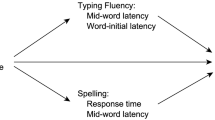Abstract
The present study aimed to describe the methods of writing used by university faculty and to explore relationships between method and productivity in writing. The survey reported here examined the cognitive strategies, tools, work scheduling, environment, and rituals used by 121 science and engineering faculty members in writing technical documents such as journal articles. The most commonly reported methods (e.g., the cognitive strategy of mentally planning large units of text structure and selecting a pen or pencil for a tool) were uncorrelated with reported productivity. Selecting a quiet work environment was the only typical habit that was associated with high productivity. Three other aspects of writing method were also related to high productivity, but they were not widely employed. These were using a dictation machine, preparing detailed written outlines before beginning a first draft, and the ritual of exercising vigorously before or during a writing session.
Similar content being viewed by others
References
Bell, P. A., Fisher, J. D., Loomis, R. J. (1978).Environmental Psychology Philadelphia: Saunders.
Boice, R. (1982). Increasing the writing productivity of “blocked” academicians.Behavior Research and Therapy 20: 197–207.
Boice, R., and Johnson, K. (1984). Perception and practice of writing for publication by faculty at a doctoral-granting university.Research in Higher Education 21: 33–43.
Bridwell, L. S., Nancarrow, P. R., and Cross, D. (1984). The writing process and the writing machine: current research on word processors relevant to the teaching of composition. In R. Beach and L. S. Bridwell (eds.),New Directions in Composition Research pp. 381–398. New York: Guilford.
Cowley, M. (1959).Writers at Work, the Paris Review Interviews. New York: Viking.
Daiute, C. A. (1984). Performance limits on writers. In R. Beach and L. S. Bridwell (eds.),New Directions in Composition Research pp. 205–224. New York: Guilford.
Elbow, P. (1981).Writing with Power. New York: Oxford University Press.
Emig, J. (1971). The composing processes of twelfth graders. National Council of Teachers of English Research Report No. 13. Urbana, IL.
Erickson, M. H. (1972). A special inquiry with Aldous Huxley into the nature and character of various states of consciousness. In Charles T. Tart (ed.),Altered States of Consciousness. Garden City, N.Y.: Doubleday.
Ewing, E. D. (1974).Writing for Results. New York: Wiley.
Flower, L., and Hayes, J. R. (1980). The dynamics of composing: making plans and juggling constraints. In Lee W. Gregg and Erwin R. Steinberg (eds.),Cognitive Processes in Writing. Hillsdale, N.J.: Erlbaum.
Glynn, S. M., Britton, B. K., Muth, D., and Dogan, N. (1982). Writing and revising persuasive documents: cognitive demands.Journal of Educational Psychology 74: 557–567.
Gould, J. D. (1980). Experiments on composing letters: some facts, some myths, and some observations. In Lee W. Gragg and Erwin R. Steinberg (eds.),Cognitive Processes in Writing pp. 97–128. Hillsdale, N.J.: Erlbaum.
Gould, J. D., Conti, J., and Hovanyecz, T. (1983). Composing letters with a simulated listening typewriter.Communications of the ACM 26: 295–308.
Hartley, J., ed. (1980).The Psychology of Written Communication. London: Nichols.
Hartley, J., and Knapper, C. K. (1984). Academics and their writing.Studies in Higher Education 9: 151–167.
Lowenthal, D., and Wason, P. C. (1977). Academics and their writing.London Times Literary Supplement, June 24, p. 782.
Moran, C. (1983). Word processing and the teaching of writing.Electronic Media, March, pp. 113–115.
Pelz, D. C., and Andrews, F. M. (1976).Scientists in Organizations Ann Arbor: Institute for Social Research, University of Michigan.
Plimpton, G. (1963).Writers at Work, the Paris Review Interviews. New York: Viking.
Stein, M. I. (1974).Stimulating Creativity, Vol. 1. Individual Procedures. New York: Academic Press.
Tebeaux, E. (1983). Keeping technical writing relevant (or, how to become a dictator).College English 45: 174–183.
Zinsser, W. (1983).Writing with a Word Processor. New York: Harper & Row.
Author information
Authors and Affiliations
Rights and permissions
About this article
Cite this article
Kellogg, R.T. Writing method and productivity of science and engineering faculty. Res High Educ 25, 147–163 (1986). https://doi.org/10.1007/BF00991488
Issue Date:
DOI: https://doi.org/10.1007/BF00991488




